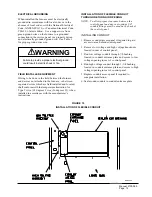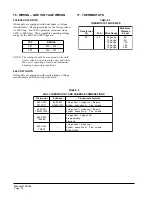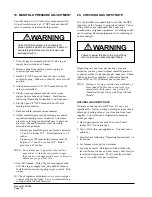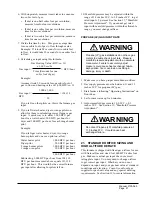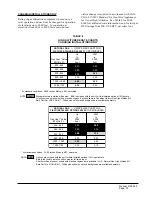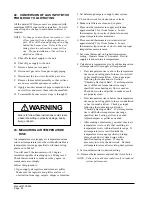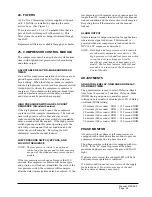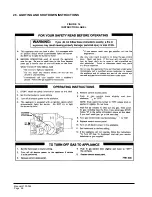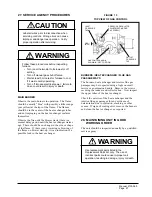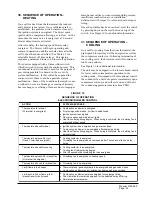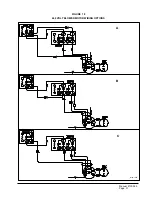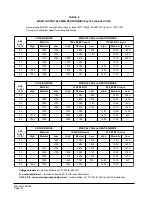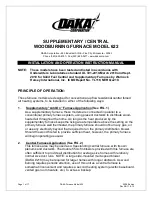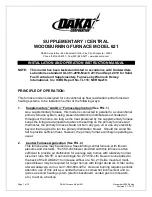
Manual 2100-365
Page 29
30. SEQUENCE OF OPERATION –
HEATING
On a call for heat from the thermostat, the induced
draft blower is energized. Once sufficient draft is
established, the pressure switch contacts close and
the ignition system is energized. The direct spark
ignitor will be energized allowing gas to flow. At the
same time the main valve is energized, a 30 second
blower delay timer is activated.
After this delay, the heating speed blower relay
energizes. The blower will begin operating and
remain in operation until the set delay time after the
call for heat has been satisfied. (See Table 12 for
selectable blower off time delays.) This timing
sequence guarantees blower on, blower off operation.
This unit is equipped with a flame rollout switch
which is wired in series with the control circuit. This
is a manual reset switch and is used for the purpose of
preventing possible fire hazard in the event of a
system malfunction. If this switch has opened the
control circuit, there could be a possible system
malfunction. Some of the conditions that might cause
a rollout to occur are blockage or sooting of primary
heat exchanger, overfiring of furnace due to improper
main burner orifices or incorrect manifold pressure,
insufficient combustion air, or installation
deficiencies with respect to return air duct design or
sizing.
Once the problem has been resolved, reset the switch
by pressing down on the reset button on top of the
switch. See Figure 16 for additional information.
31. SEQUENCE OF OPERATION –
COOLING
On a call for cooling from the room thermostat, the
high speed blower relay will be energized as well as
the compressor contactor. Following termination of
the cooling cycle, the blower motor will continue to
run for one minute.
See Figure 16 for additional information.
The unit may be equipped with a low ambient control
for lower outdoor temperature operation in the
cooling mode. If equipped with this optional control
the condenser fan will not operate immediately upon
compressor start-up, and will cycle on and off until
the condensing pressure remains above PSIG.
FIGURE 16
SEQUENCE OF OPERATION
ELECTRONIC BLOWER CONTROL
N
O
I
T
C
A
E
S
N
O
P
S
E
R
M
E
T
S
Y
S
.
t
a
e
h
r
o
f
s
ll
a
c
t
a
t
s
o
m
r
e
h
T
)
.
d
e
z
i
g
r
e
n
e
s
i
l
a
n
i
m
r
e
t
W
(
a
a
a
a
a
.
d
e
z
i
g
r
e
n
e
s
i
r
e
w
o
l
b
r
i
a
n
o
i
t
s
u
b
m
o
C
.
d
e
h
s
il
b
a
t
s
e
s
i
w
o
l
f
r
i
A
.
s
e
k
a
m
h
c
t
i
w
s
g
n
i
v
o
r
p
r
i
A
.
d
e
z
i
g
r
e
n
e
s
i
m
e
t
s
y
s
n
o
i
t
i
n
g
I
.
s
t
h
g
il
r
e
n
r
u
b
n
i
a
m
d
n
a
s
n
e
p
o
e
v
l
a
v
s
a
G
s
i
n
a
f
g
n
i
t
a
l
u
c
r
i
c
e
h
t
,
e
t
e
l
p
m
o
c
s
i
g
n
i
m
i
t
n
e
h
W
.
s
n
i
g
e
b
g
n
i
m
i
t
y
a
l
e
d
n
o
n
a
f
t
a
e
H
.
d
e
e
p
s
t
a
e
h
t
a
d
e
z
i
g
r
e
n
e
.
t
a
e
h
r
o
f
ll
a
c
s
d
n
e
t
a
t
s
o
m
r
e
h
T
a
a
a
.
s
e
s
o
l
c
e
v
l
a
v
s
a
g
d
n
a
d
e
z
i
g
r
e
n
e
-
e
d
s
i
m
e
t
s
y
s
n
o
i
t
i
n
g
I
.
g
n
i
m
i
t
e
g
r
u
p
t
s
o
p
r
e
t
f
a
d
e
z
i
g
r
e
n
e
-
e
d
s
i
r
e
w
o
l
b
r
i
a
n
o
i
t
s
u
b
m
o
C
s
i
n
a
f
g
n
i
t
a
l
u
c
r
i
c
e
h
t
,
e
t
e
l
p
m
o
c
s
i
g
n
i
m
i
t
n
e
h
W
.
s
n
i
g
e
b
g
n
i
m
i
t
y
a
l
e
d
f
f
o
n
a
f
t
a
e
H
.
d
e
z
i
g
r
e
n
e
-
e
d
.
l
o
o
c
r
o
f
ll
a
c
s
n
i
g
e
b
t
a
t
s
o
m
r
e
h
T
)
.
d
e
z
i
g
r
e
n
e
s
l
a
n
i
m
r
e
t
Y
d
n
a
G
(
a
a
.
d
e
z
i
g
r
e
n
e
s
i
r
o
t
c
a
t
n
o
c
g
n
il
o
o
C
y
a
l
e
d
n
o
n
a
f
l
o
o
c
d
n
o
c
e
s
7
r
e
t
f
a
d
e
e
p
s
l
o
o
c
n
o
d
e
z
i
g
r
e
n
e
s
i
n
a
f
g
n
i
t
a
l
u
c
r
i
C
.
g
n
i
m
i
t
.
g
n
il
o
o
c
r
o
f
ll
a
c
s
d
n
e
t
a
t
s
o
m
r
e
h
T
a
a
a
.
d
e
z
i
g
r
e
n
e
-
e
d
s
i
r
o
t
c
a
t
n
o
c
g
n
il
o
o
C
.
s
n
i
g
e
b
g
n
i
m
i
t
y
a
l
e
d
f
f
o
n
a
f
g
n
il
o
o
C
.
d
e
z
i
g
r
e
n
e
-
e
d
s
i
n
a
f
g
n
i
t
a
l
u
c
r
i
c
e
h
t
s
d
n
o
c
e
s
0
6
r
e
t
f
A
.
n
a
f
l
a
u
n
a
m
r
o
f
ll
a
c
s
n
i
g
e
b
t
a
t
s
o
m
r
e
h
T
)
.
d
e
z
i
g
r
e
n
e
s
i
l
a
n
i
m
r
e
t
G
(
a
.
d
e
e
p
s
g
n
i
t
a
e
h
n
o
d
e
z
i
g
r
e
n
e
s
i
n
a
f
g
n
i
t
a
l
u
c
r
i
C
.
n
a
f
l
a
u
n
a
m
r
o
f
ll
a
c
s
d
n
e
t
a
t
s
o
m
r
e
h
T
a
.
d
e
z
i
g
r
e
n
e
-
e
d
s
i
n
a
f
g
n
i
t
a
l
u
c
r
i
C
.
s
n
e
p
o
)
t
u
o
ll
o
r
e
m
a
l
f
(
t
i
m
i
L
a
a
.
s
e
s
o
l
c
e
v
l
a
v
s
a
g
d
n
a
d
e
z
i
g
r
e
n
e
-
e
d
e
r
a
m
e
t
s
y
s
n
o
i
t
i
n
g
i
d
n
a
t
a
t
s
o
m
r
e
h
T
.
d
e
z
i
g
r
e
n
e
e
r
a
d
e
e
p
s
t
a
e
h
n
a
f
g
n
i
t
a
l
u
c
r
i
c
d
n
a
r
e
w
o
l
b
r
i
a
n
o
i
t
s
u
b
m
o
C
t
u
o
ll
o
r
e
m
a
l
f
r
o
)
t
e
s
e
r
o
t
u
a
(
t
i
m
i
L
.
d
e
s
o
l
c
t
i
u
c
r
i
c
)
t
e
s
e
r
l
a
u
n
a
m
(
a
a
a
.
g
n
i
m
i
t
e
g
r
u
p
t
s
o
p
r
o
f
d
e
z
i
g
r
e
n
e
s
n
i
a
m
e
r
r
e
w
o
l
b
r
i
a
n
o
i
t
s
u
b
m
o
C
.
g
n
i
m
i
t
f
f
o
y
a
l
e
d
d
e
t
c
e
l
e
s
e
h
t
r
o
f
d
e
z
i
g
r
e
n
e
s
n
i
a
m
e
r
n
a
f
n
o
i
t
a
l
u
c
r
i
c
e
h
T
.
s
e
m
u
s
e
r
n
o
i
t
a
r
e
p
o
l
a
m
r
o
N
Summary of Contents for WG421
Page 8: ...Manual 2100 365 Page 5 MIS 1352 FIGURE 1 UNIT DIMENSIONS...
Page 12: ...Manual 2100 365 Page 9 FIGURE 4 MOUNTING INSTRUCTIONS MIS 1472...
Page 15: ...Manual 2100 365 Page 12 FIGURE 8 COMMON WALL MOUNTING INSTALLATIONS MIS 1474...
Page 20: ...Manual 2100 365 Page 17 FIGURE 11 LOW VOLTAGE WIRING MIS 1162...
Page 21: ...Manual 2100 365 Page 18 FIGURE 12 GAS PIPE CONNECTION MIS 1478...
Page 29: ...Manual 2100 365 Page 26 26 LIGHTING AND SHUTDOWN INSTRUCTIONS FIGURE 14 INSTRUCTION LABEL...
Page 34: ...Manual 2100 365 Page 31 FIGURE 18 460 VOLT BLOWER MOTOR WIRING OPTIONS MIS 1487 A B C...
Page 41: ...Manual 2100 365 Page 38...
Page 42: ...Manual 2100 365 Page 39...
Page 43: ...Manual 2100 365 Page 40...
Page 44: ...Manual 2100 365 Page 41...
Page 45: ...Manual 2100 365 Page 42...
Page 46: ...Manual 2100 365 Page 43...
Page 47: ...Manual 2100 365 Page 44...
Page 48: ...Manual 2100 365 Page 45...
Page 49: ...Manual 2100 365 Page 46...
Page 50: ...Manual 2100 365 Page 47...
Page 51: ...Manual 2100 365 Page 48...
Page 52: ...Manual 2100 365 Page 49...

